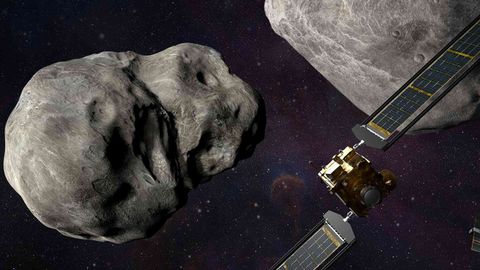
On the evening of Monday, a far-fetched science-fiction event will unfold before our eyes: NASA will send a spacecraft crashing into an asteroid that’s roughly the size of St. Paul’s Cathedral in London. By Stephanie Vermillion
Fear not; we’re not experiencing “Armageddon” IRL.
Everything to know about the NASA Spacecraft that will be crashing into an asteroid
DART, short for Double Asteroid Redirect mission, was designed to test our planetary defence capabilities if an asteroid were to threaten Earth in the future, according to the DART mission website. NASA first sent the DART spacecraft in November 2021, according to NASA; its official crash-time estimate is 7:14 pm ET (4:44 am next day).
What happens if an asteroid hits Earth?
Past catastrophes prove the need for this kind of space-object-defence system. Take the 2013 meteor explosion near Chelyabinsk, Russia. According to EarthSky.org, it generated up to 30 times the energy of the Hiroshima atomic bomb. The explosion wreaked havoc on six Russian cities and sent 1,500 people to the hospital. And of course, there’s also the extinction of the dinosaurs, which most scientists believe stemmed from an asteroid crash some 66 million years ago, according to the Natural History Museum in London.
To be clear, NASA knows of no asteroids that are both on track to collide with Earth and large enough to do major harm, according to Space.com. That said, they’re aware of roughly 30,000 near-Earth asteroids; that number grows daily.
How will the DART mission work?

With DART, NASA is testing a kinetic impact deflection method against the asteroid Dimorphus, a non-threatening asteroid moonlet that orbits the larger asteroid Didymos. It’s the first time NASA will test this kind of technology in space; it involves sending a high-speed spacecraft to disrupt the asteroid’s orbital path, according to NASA. The deflection system would alter the trajectory, ultimately moving it away from Earth.
“It’s the first time we are rearranging a celestial body’s orbit,” Andy Rivkin, DART investigation team lead from Johns Hopkins Applied Physics Lab, said in a Wall Street Journal film on the topic. Rivkin said the speed of the crashing spacecraft will be around 14,000 miles per hour (22530 kmph). Dimorphus will be roughly 7 million miles (11265408 km) away from Earth when the DART spacecraft crashes into it.
The interstellar collision isn’t the only touch of sci-fi to expect from Monday’s event. DART will also use SMART Nav, a system that lets the DART spacecraft navigate on its own, sans operator assistance. SMART Nav is intelligent enough to distinguish between Didymos and Dimorphos; it will manoeuvre itself for the mission’s final four hours before speeding into the latter, according to the mission website.
How can I watch the DART mission?
Tune into this first-of-its-kind mission via NASA’s live coverage on the NASA TV YouTube channel. The organisation will also run a separate video stream with real-time images from DART’s DRACO camera.
The camera, the only instrument onboard the spacecraft, will send one image per second back to Earth. This live feed will start as a largely black screen with one light source — the Didymos asteroid system, according to the dedicated DRACO YouTube livestream page. As impact nears, the point of light will increase until the detailed asteroids are visible. After impact, the feed will turn to black (it will then run replays to relive the collision.)
This story first appeared on www.travelandleisure.com
Main and Feature Image Credit: NASA/Johns Hopkins, APL/Steve Gribben
Related: Hilton Is Building Astronaut Hotel Rooms In Space










